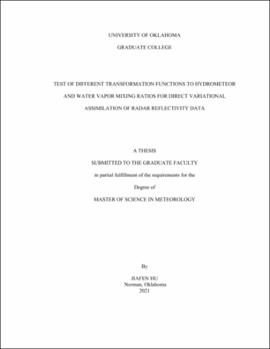| dc.contributor.advisor | Zhang, Guifu Jr | |
| dc.contributor.advisor | Gao, Jidong Jr | |
| dc.contributor.author | Hu, Jiafen Jr | |
| dc.date.accessioned | 2021-05-12T15:08:37Z | |
| dc.date.available | 2021-05-12T15:08:37Z | |
| dc.date.issued | 2021-05-14 | |
| dc.identifier.uri | https://hdl.handle.net/11244/329530 | |
| dc.description.abstract | Many issues exist when using highly nonlinear radar reflectivity forward observation operator in three-dimensional variational data assimilation methods (3DVAR), especially with hydrometeor mixing ratios as control variables (denoted as Q). One of the outstanding problems is when hydrometeor mixing ratios from the model background are very small, the cost function gradient can be extremely large, which causes slow convergence. In order to solve this problem, two methods were recently proposed. One uses logarithmic hydrometeor mixing ratios (LOGQ) as control variables during minimization process. Another uses power transformed mixing ratios (PQ), which applies a power parameter p to the variable transformation, as new control variables.
In this study, all three methods are implemented in a weather adaptive, high-resolution, deterministic Warn-on-Forecast analysis and forecast system and tested on three severe weather events that occurred during the Hazardous Weather Testbed (HWT) spring experiment period in May 2019. Radar reflectivity and radial velocity are assimilated along with pseudo-water vapor observations derived from vertically integrated liquid water. The power transformation function is also applied on water vapor mixing ratios to test the impact. Both qualitative and quantitative evaluation are performed on 0–3-hour forecasts launched hourly from 1900 to 2300 UTC for each of the 3 cases. It is found that analysis performance in experiments with PQ and LOGQ as control variables are better than those experiments with Q. The convergence rate of cost function minimization with PQ is faster than the experiments with Q. It is also found spurious analysis increments are produced in experiments with Q and LOGQ sometimes. Using PQ as control variables can alleviate this problem which produces less spurious analysis increment and slightly improves short-term severe forecasts compared to Q as control variables. Applying power transformation function to pseudo-water vapor is shown to have little benefit to the performance of analysis and forecast. | en_US |
| dc.language | en_US | en_US |
| dc.subject | Data Assimilation | en_US |
| dc.subject | 3DVAR | en_US |
| dc.subject | NWP | en_US |
| dc.title | TEST OF DIFFERENT TRANSFORMATION FUNCTIONS TO HYDROMETEOR AND WATER VAPOR MIXING RATIOS FOR DIRECT VARIATIONAL ASSIMILATION OF RADAR REFLECTIVITY DATA | en_US |
| dc.contributor.committeeMember | Xu, Feng Jr | |
| dc.contributor.committeeMember | Heinselman, Pam Jr | |
| dc.date.manuscript | 2021-05-10 | |
| dc.thesis.degree | Master of Science in Meteorology | en_US |
| ou.group | College of Atmospheric and Geographic Sciences::School of Meteorology | en_US |
